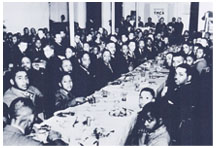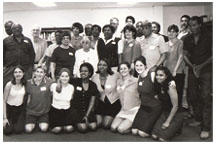May 14, 2003: Features

|
Above, men and boys enjoy the John-Witherspoon community’s annual father-and-son banquet in the late 1940s. The banquet was held at the old Y.M.C.A., which is now the site of the Arts Council of Princeton. (princeton historical society)
Students and residents celebrate their oral history project in May 2001: Front row (from left), Jessica Hafkin ’03, Celia Riechel ’04, Lauren Miller ’03, Mia Powell ’03, Katherine Jackson ’03, Jenny Hildebrand ’03, Jessica Lautin ’03, and Saloni Doshi ’03; second row (from left): Hank Pannell, Fannie Floyd, Harriett Calloway, Joan Hill, lecturer Kathryn Watterson, Trisha Thorme (assistant director for community-based learning and training), and Romas Broadway; back row (from left), the Rev. Judson Carter, Tom Hartman, Marsha Hartman, Wilma Pannell, Shirley Satterfield, Clyde “Buster” Thomas, Marilyn Yates, Jim Floyd Sr., Karim Thomas ’04, Marlo McGriff ’04, Janet Dickerson (vice president for campus life), and Jim Floyd Jr. ’69. |
The
other side of paradise
Princeton students cross
Nassau Street to tell the story of a changing community
By Kathryn Federici Greenwood
When Henry Pannell was growing up in Princeton’s black neighborhood, he would swim and fish in Stony Brook, camp out in Devil’s Cave on Mt. Lucas Road, and have BB-gun wars and pick berries where the Princeton Shopping Center now stands. People didn’t lock their doors, teachers lived in the community, and residents could find nearly everything they wanted – schools, barbers, restaurants, and churches – almost around the corner. “I wouldn’t trade one second of my childhood,” says Pannell, 64 and a third-generation Princeton resident.
But over the years, Pannell’s community, known as the John-Witherspoon neighborhood, has changed. Older members have been squeezed out by rising housing costs, children have moved away, whites and Hispanics have moved in. So four years ago, when Princeton lecturer Kathryn Watterson was looking for volunteer opportunities for students in her community-based learning seminar and ran into Pannell, he offered an idea. “What we really want is a history of this community,” Pannell told her. “I don’t think my grandson will see remotely what this community was like when I was a child.”
After that meeting, Watterson assigned students in two seminars to interview older members of the John-Witherspoon neighborhood — many of whom had worked on campus “shining shoes for a nickel, cooking, waiting tables,” Watterson notes — and to comb through archives at Princeton’s Historical Society. Even when the classes ended, Watterson and her students continued working on the interviews, shaping and editing them into a book called I Hear My People Singing: An Oral History of African-American Princeton, 1900 to 2000. This summer, Watterson, the author of nine books, plans to find a publisher. The book will include more than 50 interviews, a historical timeline, and an essay on the history of Princeton’s African Americans. Profits will be donated to the Princeton Nursery School, which many of those interviewed had attended.
At first, some John-Witherspoon residents were reluctant to talk with Princeton students because many had been approached as “subjects” by students working on papers in the past. “Some people in the community were not too jazzed about another Princeton group descending upon the community to do some research and then to leave again,” says Celia Riechel ’04, who interviewed Florence Twyman, an 87-year-old woman who has lived in Princeton most of her life.
Before Riechel – “a fairly well-off white kid from Ohio” – interviewed Twyman at her two-story home on Birch Avenue, she was nervous that she would offend the older woman. But Riechel calls the interview “one of the most fantastic experiences of my Princeton career.” Listening to personal histories made Riechel’s academic lessons come alive, she says: “I could place my Princeton education in the world.”
Twyman’s accounts of her experiences with racism took Riechel by surprise, particularly when Twyman recalled her first job as a domestic worker for a professor’s wife in the 1930s:
“I had to cook, feed, and teach the kids, clean the house, and do anything I was told to do. I got 35 cents an hour, but if I worked fast, she’d pay me 50 cents. . . . My sister taught me you don’t keep anything like nice clothes in the home of your employer. If they thought you were doing too well, they’d fire you. . . . If your employer picked you up, you had to sit in the back seat. And when you went to the house, you couldn’t go in the front door.”
Before taking Watterson’s course, Riechel, like many Princeton students, rarely ventured to the other side of Nassau Street. To many students, says Riechel, an anthropology major, residents of that neighborhood still “exist in their roles as employees. They serve our food and then they disappear.”
Linda Madueme ’03, a Nigerian student who grew up in Austria and Canada, says she got “a glimpse into this totally different kind of life” in which people focused on family, discipline, and respect, when she spoke with Alice Satterfield in her home on Quarry Street. “I remember so vividly coming out of the front door in the afternoon when we were dismissed from school,” Satterfield told Madeume. “The teachers would stand right out that door, and we had to march out two-by-two. They would say, ‘All right, you go directly home, and no foolishness, you go right home and study.’ . . . The elderly people, if they saw you doing something on the street which you knew was not right or not proper to do – they would reprimand you and then call your parents. . . . Everybody was just like one big family. . . . You didn’t have a lot, but we had wonderful family love and care.”
Watterson’s students also were surprised to learn about what many residents view as the devastating impact of integration on their educations. “Once the schools were integrated in 1947, African Americans lost a lot in terms of the kind of support they got from teachers,” says Watterson. Before integration, black children attended the Quarry Street School for Colored Children; those interviewed said teachers there cared deeply about their students and held high expectations,
“I just thank God for the wonderful teachers that I had prior to the integration of schools, and that I got that basic education through third grade,” Pannell told Watterson. “Because when we went to Nassau Street School, things changed. That’s when I found out about discrimination. I really feel as though I was cheated. . . . We were pretty much ignored in the classroom.”
Joseph P. Moore told Ethan Meers ’03 that “it was sort of an unwritten law that you didn’t go across” Nassau Street. “You had this innate fear of cops, just because you were black. . . . You could be walking up the street, and they’d slow the car, stop the car, and harass you. . . . We were literally told 100 times, ‘You do not belong in this neighborhood.’” In 1969, Moore was named Princeton’s assistant dean of students, becoming the second African-American dean; he later was the borough’s police and fire commissioner.
Moore’s assessment that the struggle for equality is far from over – that “you being born white and me being born black is a quirk that is going to make our experiences dramatically different” – left Meers feeling discouraged. Says Meers, a history major: “That was disheartening, especially for someone from my generation who thought we had the civil rights movement and we’re beyond that.”
By recording a neglected history, the students heard about the town and the university from a different point of view, and it made a few students rethink, in particular, Woodrow Wilson 1879, Princeton’s 13th president, who discouraged blacks from applying to the university. Wilson wrote in 1904 that “the whole temper and tradition of the place are such that no Negro has ever applied for admission, and it seems extremely unlikely that the question will ever assume a practical form.”
“Woodrow Wilson is seen as such a big, important, respectable figure here. And this made me realize, for most of the people outside of the university community . . . that wasn’t the case,” says Lauren Miller ’03, who conducted and edited some of the interviews.
Jessica Lautin ’03, who interviewed residents both for I Hear My People Singing and for her senior thesis on Princeton’s black community and its relationship with the university, hopes the projects will educate people about the rich history of the African-American community. “It just makes me sad that students and faculty don’t know more about this community that is so inextricably connected with the history of the university,” says Lautin. She first learned about the neighborhood when she wrote about it for the Daily Princetonian during her freshman year. One of the first people she interviewed was Albert Hinds, who, at 101, is one of the oldest community members.
Exploring the community has made Lautin “feel a passionate desire to want to improve things” and to want to better town-gown relations. “Princeton students often see the campus and the larger world outside the campus but somehow miss . . . what is happening a little beyond the Princeton gates,” she says. Next year Lautin hopes to turn her thesis, “That Side of Paradise,” into a book.
“One of the richest things about my Princeton experience has been
becoming friends with people in this neighborhood,” says Lautin.
“When I did that original article freshman year [for the Daily Princetonian],
I remember standing in front of the American Legion and just getting these
hostile looks. . . . People were suspicious about why I was there and
what I was doing. A few weeks ago, I went in to interview Mr. Hinds for
my thesis, but it was as much getting together as friends as my doing
work. We had mincemeat pie.” ![]()
Kathryn Federici Greenwood is an associate editor at PAW.
Related links:
http://www.princeton.edu/~cbli/
This is the link to the university's community based learning initiative.


